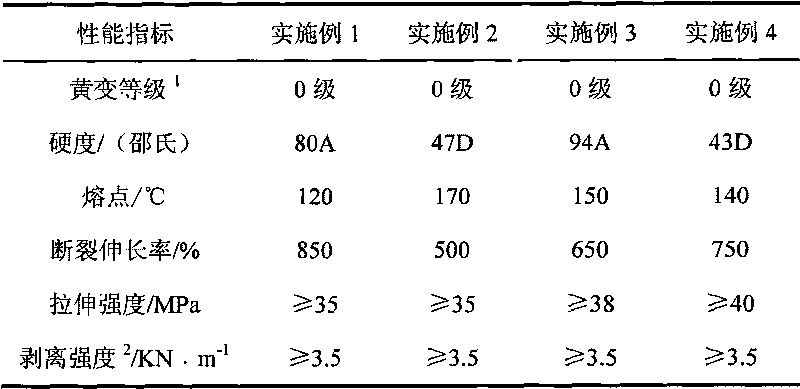Non-yellowing thermoplastic polyurethane hot melt adhesive and preparation method thereof
A thermoplastic polyurethane and hot-melt adhesive technology, applied in the field of polyurethane hot-melt adhesives, can solve the problems of shortening the service life of bonding products, shortening the service life of bonding products, yellowing of polyurethane hot-melt adhesives, etc., and achieves easy operation and low cost. , the effect of improving heat resistance
- Summary
- Abstract
- Description
- Claims
- Application Information
AI Technical Summary
Problems solved by technology
Method used
Image
Examples
Embodiment 1
[0027] Take 50g of polybutylene adipate (number-average molecular weight: 2500), 30g of polyethylene glycol (number-average molecular weight: 1000), dehydrate under vacuum at 110-120°C for 3-4 hours, and determine that the water content is less than 0.05%. Yes; lower the temperature to 70-75°C, add 2g of fumed silica (10-50nm), 0.01g of dibutyltin dilaurate as a catalyst, 0.02g of stannous octoate, 0.02g of γ-aminopropyltriethoxysilane and 1 , 3.60g of 4-butanediol, after stirring evenly, add 15.13g of 1,6-hexamethylene diisocyanate, react for 5-10min, and vacuumize (the maximum vacuum degree is 0.67KPa) for 3-5min to defoam. When finished, stop stirring, release the vacuum, pour it into a preheated polytetrafluoroethylene tray and mature at 110-120°C for 4-6 hours, and you can get a non-yellowing thermoplastic polyurethane hot melt adhesive.
Embodiment 2
[0029] Take 80g of polybutylene adipate (number-average molecular weight: 2000) and 10g of polycaprolactone (number-average molecular weight: 2000), and vacuum dehydrate at 110-120°C for 3-4 hours, and determine that the water content is less than 0.05%. Yes; cool down to 70-75°C, add 2g of fumed silica (10-50nm), 2g of nano-titanium dioxide, 0.02g of dibutyltin dilaurate as catalyst, 0.04g of γ-aminopropyltriethoxysilane, 1,4 -Butanediol 3.65g, stir to make it completely and uniformly mixed with polyol, add 9.5g of isophorone diisocyanate, 11.2g of dicyclohexylmethane diisocyanate to react for 5-10min, and vacuumize (maximum vacuum degree is 0.67KPa ) defoaming for 3-5 minutes, when the air bubbles are basically exhausted, stop stirring, release the vacuum, pour it into a preheated polytetrafluoroethylene tray and mature at 110-120°C for 4-6 hours, and you can get high-hardness non-yellowing thermoplastic Polyurethane hot melt adhesive.
Embodiment 3
[0031] Take 50.0g of polytrimethylene adipate (number average molecular weight is 3000), 10.0g of polycaprolactone (number average molecular weight of 2000), 30.0g of polytetrahydrofuran diol (number average molecular weight of 2000), at 110~120℃ Under vacuum dehydration for 3-4 hours, it is enough to measure the water content to be less than 0.05%; lower the temperature to 70-75°C, add 2.5g of fumed white carbon black (10-50nm), 2.0g of nano-titanium dioxide, and 0.02g of catalyst dibutyltin dilaurate, 0.06g of γ-aminopropyltriethoxysilane, 3.3g of methylpropanediol, stir to make it completely and evenly mixed with polyol, add 11.5g of dicyclohexylmethane diisocyanate, 4.9g of 1,6-hexamethylene diisocyanate to react 5 ~10min, and vacuumize (the maximum vacuum degree is 0.67KPa) for degassing for 3~5min. When the bubbles are almost exhausted, stop stirring, release the vacuum, pour into the preheated polytetrafluoroethylene tray and mature at 110~120℃ After 4-6 hours, a transp...
PUM
 Login to View More
Login to View More Abstract
Description
Claims
Application Information
 Login to View More
Login to View More - R&D
- Intellectual Property
- Life Sciences
- Materials
- Tech Scout
- Unparalleled Data Quality
- Higher Quality Content
- 60% Fewer Hallucinations
Browse by: Latest US Patents, China's latest patents, Technical Efficacy Thesaurus, Application Domain, Technology Topic, Popular Technical Reports.
© 2025 PatSnap. All rights reserved.Legal|Privacy policy|Modern Slavery Act Transparency Statement|Sitemap|About US| Contact US: help@patsnap.com

